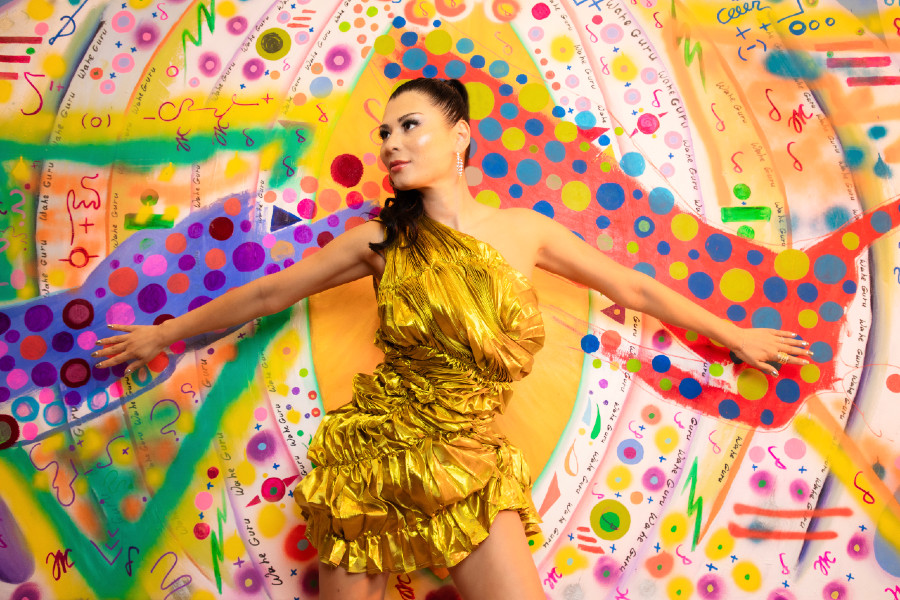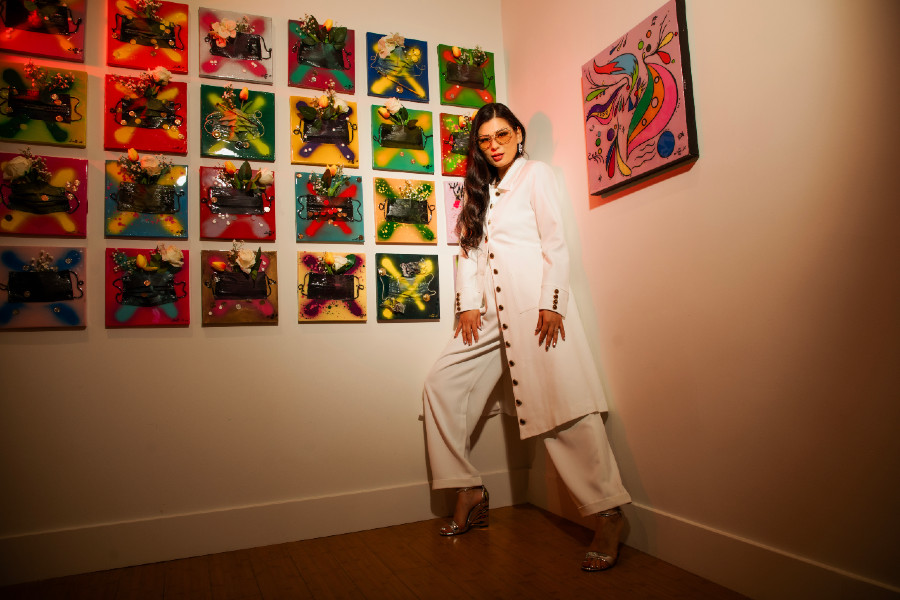Prior to becoming a celebrated artist, gallerist, entrepreneur, and fashion designer, Lissa Mel came face to face with a cusp of transition, a life-changing moment, where she decided to abandon herself to pursue art full-time.
Thomas Merton called such a cusp ‘point vierge,’ “the point where conversion begins in the human heart – the point between being and non-being, between darkness and light.”
Lissa Mel made the right decision. Since then, she’s created hundreds of pieces of artwork, works represented by the Centaur Gallery in Las Vegas and at her own Santa Monica-based gallery, The Messengers Art Gallery.
In 2022, she merged her two passions, painting and fashion, and launched her own hoodie and apparel collection – Loren Marie – and collaborated with designers like Michael Kors.
Lissa Mel’s art explores matter at a molecular level using abstract depictions to capture performance while mirroring the vibrational waves of matter. Her view of the human body is that of a vessel performing the dance of the natural realm and depicting the interaction between the feminine and masculine energies.
Born in Uzbekistan and raised in Israel, Mel spent most of her life in Tel Aviv where her mother encouraged her artistic talents from a young age. In high school, her love for science led her to study physics, chemistry, and biology. However, it was her passion for the arts that eventually took center stage and gave way to a focus on painting, sculpture, and cinema.
CelebMix spoke with Lissa Mel to find out why she makes art, her influences, her inspirations, and the role of artists in society.
What three things can’t you live without?
Three essential elements define my life: art, meditation, and books. Art is the pulse of my creativity, an essential outlet for my emotions and visions. It connects me with the beauty of the world. Meditation offers me sanctuary amidst life’s turbulences, providing inner peace and mindfulness. It’s my daily anchor, guiding me to balance and inspiring creative ideas. Books are my constant companions, also providing me with inspiration and nourishing my intellect. These three passions are not optional; they are the essence of my being. I cannot imagine a life without them.
Why do you make art?
Creating art is as essential to me as breathing. When I’m not immersed in the creative process, I feel a profound sense of loss and disconnection. To be in harmony with the universe, I must create art at least a few times a week; it’s the very core of my happiness and fulfillment.
Where are you from and how does that affect your work?
I grew up in Tashkent, Uzbekistan, where I spent the first ten years of my life. It’s where I began my journey of learning. While influences are not always consciously or intentionally absorbed, I’m certain that the perceptions from my childhood, particularly the visual ones, find their way into my work. Traditional Uzbekistani art is renowned for its vibrant colors and intricate patterns. Had I grown up in a different country, my artistic style might have taken on a completely distinct form.
What motivated you to abandon the security of a career in business and move across the world and become a full-time artist?
Leaving the security of a stable job felt like taking a leap into the unknown, perhaps the most intimidating decision I’ve ever consciously made. Just one month before being accepted by a gallery, I still questioned whether it was a feasible path. However, during the pandemic, I dedicated all my lockdown days to my art. Over the course of those three years in Los Angeles, I diligently worked on my craft, producing over 167 pieces. It was during this time that I had a revelation—I would not give up. I was resolute in my commitment to create art every day, regardless of whether people purchased my work or if I was represented in galleries. It was a feeling deep within me, an unwavering determination to continue, no matter what, and to simply keep doing what I loved and felt meaningful to me.
Who are your biggest artistic influences?
My biggest inspiration in the art world is Olafur Eliasson. I’m fascinated by his work, especially his use of light and nature to create a magical experience through art and installations. It’s the type of art I aim to create in my own works. Additionally, Gustav Klimt serves as a significant inspiration for me, particularly in his use of patterns and color textures.
Tell me about your favorite medium.
Currently, my favorite medium is plexiglass. I’m exploring the captivating beauty of mirror-like reflections and engaging the viewer through the intriguing self-mirroring effects that plexiglass can create.
Where do you find inspiration?
I draw inspiration from various sources, including music, books, nature, and encounters with fellow artists. Observing their works is always a stimulating experience. Additionally, I find great inspiration in attending shows and performances, such as theater, opera, and dance performances.

Photo: Reinhardt Kenneth
When is your favorite time of day to create?
My favorite time to create is between 11 AM and 6 PM, as that’s when we typically have the most energy. I make a conscious effort to make the most of these hours for my creative work.
What role does the artist have in society?
Artists play various crucial roles in society. I’ll outline a few here. Artists have the power to reshape culture, elevating it through their creative expressions. Moreover, art possesses the remarkable ability to heal. Artists can infuse their work with healing energy, drawing from a universal human capacity for wholeness and magnifying it through their creations. Simply gazing upon an artwork can be profoundly therapeutic. Art can also provide a gateway to the present moment, much like entering a meditative state of mind.
What is an artistic outlook on life?
I can only speak from my own artistic perspective, but I believe this sentiment resonates with many artists: Life is frequently filled with challenges and demands, yet immersing oneself in the realm of creative expression and creation reintroduces us to life’s beauty and its positive aspects. It serves as both an escape from the world and a tool to enhance our existence within it.
Name three artists you’d like to be compared to.
Ulafur Eliason, Gustav Klimt, and Salvador Dali.
What is your definition of success?
The definition of success for me as an artist is to cultivate a unique perspective that inspires new generations of artists. It’s about leaving a unique mark so that emerging art students find inspiration and grant themselves permission to create without limits. True success, in my view, is measured by the positive impact on people’s lives, contributing to making the world a better place through the inspiration I provide.

